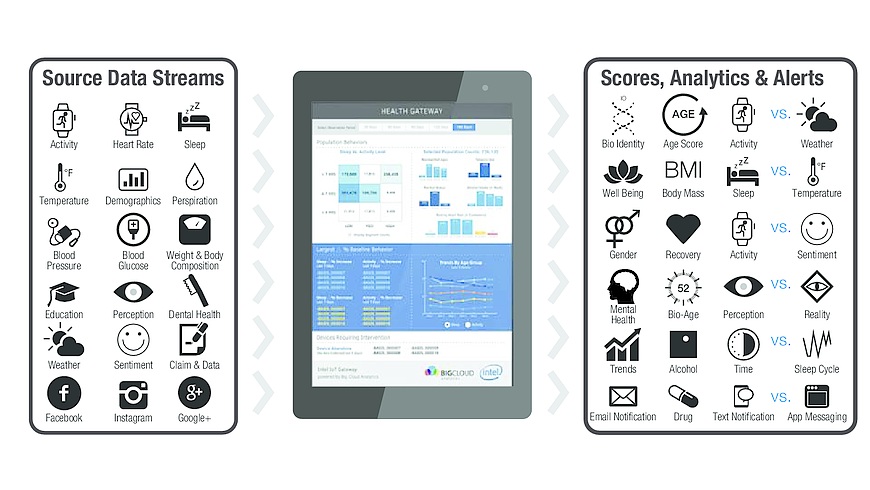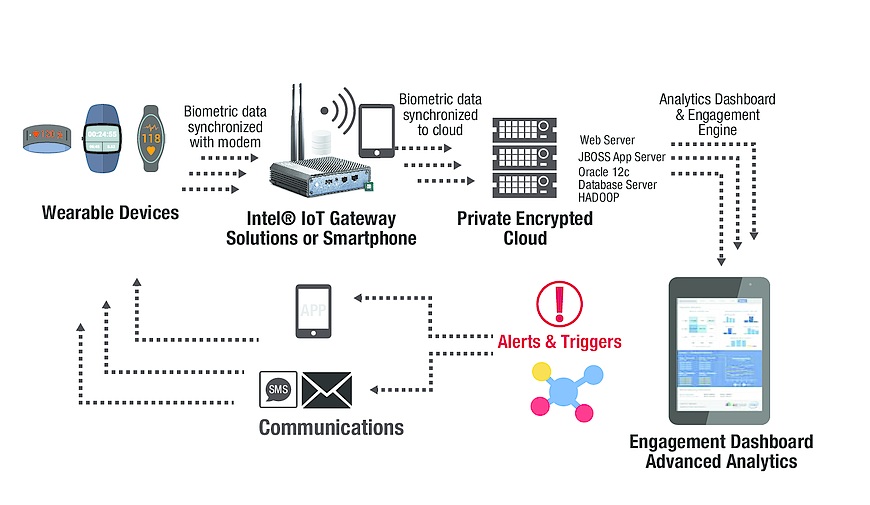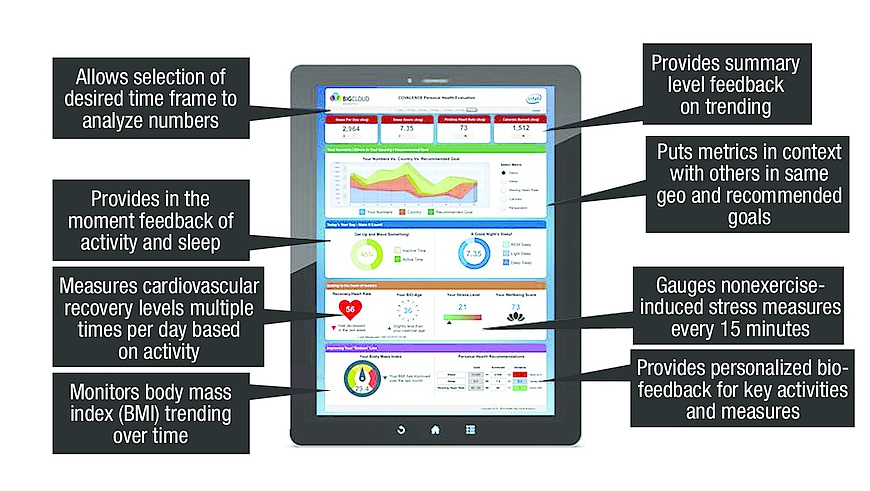Turning Healthcare Into Value
From health insurance to medical procedures, everybody wants to reduce costs while improving wellness and quality of care. Preventive healthcare programs help by promoting better health practices and disease prevention. However, providers, insurers, and employers need better data on the people they care for and insure to identify specific areas to address. At the same time, they need better ways to help people monitor their health and motivate them to improve it.
This article looks at an Internet of Things (IoT) health analytics platform that, through monitoring and analytics, delivers greater insight on specific populations. We describe the platform's components, including wearable devices, participant interfaces, provider dashboards, and analytics software. We explore how this scalable solution uses elements of the Intel® IoT Platform, including Intel® IoT Gateway Technology, to securely run locally and in the cloud. And we explain how this health analytics platform can help motivate behaviors that improve wellness and reduce treatment and insurance costs.
The Need to Encourage Healthy Lifestyles
In every healthcare sector, there is great interest in improving health. Providers want to speed up rehabilitation and recovery. Patients want to enjoy longer lives. Employers want to hold down insurance costs and keep employees healthy. Insurers want to reduce claims and rate increases.
Despite all this interest, figures from a frequently cited Wall Street Journal article, “How Safeway Is Cutting Healthcare Costs,” reveal more could be done:
- 70 percent of all healthcare costs are driven by behavior
- 74 percent of all costs are confined to four chronic conditions (cardiovascular disease, cancer, diabetes, and obesity)
- 80 percent of cardiovascular disease and diabetes are preventable
- 60 percent of cancers are preventable
- More than 90 percent of obesity is preventable
Additional motivation comes from the U.S. Centers for Disease Control and Prevention. This organization reports that the majority of chronic diseases respond well to behavioral changes. Type 2 diabetes is a good example. This disease afflicts 10 percent of the U.S. population and is costly to manage, yet it responds well to changes in exercise and diet.
Motivation through Technology
The popularity of wearable fitness bands and watches indicates a strong desire by people to improve their health. According to the International Data Corporation (IDC), total shipment volume for the second quarter of 2015 came to 18.1 million units, up 223.2 percent from the 5.6 million units shipped in the 2014 second quarter.
Unfortunately, fitness wearables alone are marginally successful. The market research firm NPD Group reports that up to a third of the users discard them in a few weeks. On the positive side, more than half wear them past three months.
Incentivizing Healthy Behavior
The COVALENCE* Health Analytics Platform provides the needed motivation to keep fitness wearables on people's wrists. A complete patient and employee engagement and management program, the platform combines bio-sensing wearables with real-time predictive analytics technology.
Developed by Big Cloud Analytics (BCA), the solution capitalizes on an important truth: Piecemeal data provides little incentive for change. People need data converted into actionable insights they can easily apply to their lives.
The COVALENCE Health Analytics Platform collects and analyzes biometric, demographic, attitudinal, and exogenous data. It then presents the data in ways that inspire positive lifestyle changes (Figure 1). This results in reduced claims and fewer admissions and readmissions for serious ailments.

Figure 1. The COVALENCE* Health Analytics Platform is a HIPAA-compliant solution that converts data streams into actionable insight to motivate healthier behaviors.
The proprietary COVALENCE modeling approach uses the world-renowned science of the company's Google Research Award winner Dr. V. Kumar. BCA's chief data scientist, Dr. Kumar is the most published data scientist in the field of engagement.
A HIPAA-compliant solution, the COVALENCE Health Analytics Platform gives care providers, insurers, and employers the ability to do the following:
- Collect and synthesize thousands of employee or patient data streams from smart watches and fitness bands
- Correlate biometrics with claims, weather, and social media data, as well as mood (self-reported)
- Obtain advanced population health-management analytics, scores, and coefficients
- Use automatic activity detection to group patients by activity level, resting heart rate, perspiration, temperature, blood glucose, sleep patterns, blood pressure, and other health parameters
- View dynamic overlays of self-reported information such as age, marital status, income, and tobacco and alcohol use
- Set up alerts for conditions such as device abandonment or elevated resting heart rate
- Guide individual health improvements through bio-feedback and event-triggered messaging
Collecting and Analyzing Biometric Data
Depending on the wearable device, the COVALENCE Health Analytics Platform securely captures over 50 biometric elements through IoT gateways or smartphones, resulting in over 72,000 data points per day. It includes patent-pending highly predictive math to analyze millions of data points and display them on an easily accessible dashboard.
Advanced algorithms combine multiple biometric daily values to deliver the COVALENCE Wellbeing Score based on a 1 to 100 scale. Rating consistency of healthy behaviors higher than intermittent bursts of participation, this unidimensional score summarizes sleep, cardiovascular, and activity habits.
Putting the Data to Use
As an example of what can be learned about a specific participant population, one BCA customer discovered the following in regard to activity:
- Participants aged 35-44 were the most active
- Participants 45 and above were the least active
- Underweight and normal body-mass-index (BMI) people were the most active
- Obese participants were the least active
- Male participants were more active than women
For the same group, sleep metrics revealed obese participants aged 30 and above had the lowest sleep duration, and women proved better sleepers than men. These results helped the customer identify which participant groups needed incentives for increasing their activity and which groups needed the most attention for sleep improvements.
BCA's solution delivers three key elements for encouraging individual change: regular communication, behavior prompting, and incentive support. Participants receive incentivizing communications and behavior prompts through their smartphones. Incentives can be similar to the discounts auto insurance companies offer to safe drivers based on data from in-car monitoring devices. Healthcare insurers can offer incentives such as lower rates and co-payments. Care providers can work with retailers to offer discounted services and merchandise, such as gym memberships, exercise equipment, and coupons for healthy food products. Employers can offer greater coverage of health insurance costs or more vacation days to participants who meet certain goals.
Employing these elements to encourage behavioral change delivers measurable results. One international BCA client accustomed to an average claim value of $36,000 USD and average claim duration of two years achieved an estimated three percent in claim reductions for a total of $15,738,000 USD in annual savings.
Bio-Identity Recognition
To ensure the integrity of health-promoting programs based on wearable devices, biofeedback solutions must protect against misrepresentation and fraudulent claims. BCA provides this protection with advanced algorithms that calculate a COVALENCE BIO Identity Score. This patent-pending equation provides a passive authentication feature requiring no user interaction. Combining multiple biometric sensor values, the COVALENCE Health Analytics Platform can detect a change in the device wearer. The chance of two individuals having the same BIO Identity Score is less than 1 in 7 billion.
Running on Intel® Technology
The COVALENCE Health Analytics Platform runs natively on gateways based on Intel® IoT Gateway Technology and uses Intel® IoT Platform elements (Figure 2). An end-to-end reference model and family of products from Intel and the industry, the Intel IoT Platform provides a foundation for seamlessly and securely connecting devices, delivering trusted data to the cloud, and delivering value through analytics.

Figure 2. The COVALENCE Health Analytics Platform runs natively on gateways based on Intel® IoT Gateway Technology and uses elements of the Intel® IoT Platform.
Intel IoT Gateway Technology efficiently aggregates and filters data from different types of sensors and protocols at the edge, allowing providers, insurers, and employers to analyze and act upon information in near-real time. With the right balance of compute-enabled intelligence at the edge, providers, insurers, and employers can provide faster response and additional services, while saving money on data transmission, storage, and analysis.
Gateways scale easily through a selection of Intel® processors, including Intel® Quark™, Intel® Atom™, and Intel® Core™ processors. The gateways enable a robust and flexible security infrastructure through processor- and software-based security features, remote manageability, and the ability to mesh public and private cloud computing environments. Within healthcare environments, the built-in security features are essential for helping protect sensitive data in electronic health records (EHR).
Wide Choice of Wearables
The COVALENCE Health Analytics Platform supports more than 60 percent of the wearable fitness devices on the market. One excellent option is the Basis Peak Fitness and Sleep Tracker by Intel. This watch includes an optical heart rate engine, a three-axis accelerometer, and skin temperature and galvanic skin-response sensors. It can send data to smartphones and IoT gateways. Both devices can perform initial processing before forwarding the data to the cloud.
Viewing the Data
Participants and administrators can view their respective interfaces in near-real time on tablets or smartphones (Figure 3). A wide selection of tablets designed for use in healthcare facilities is available from Intel® Internet of Things Solutions Alliance members. These tablets offer a range of performance through Intel® mobile and embedded processors.

Figure 3. Participants and administrators can view their respective interfaces in near-real time on tablets or smartphones.
Hosting in the Data Center or Cloud
The COVALENCE Health Analytics Platform's analytics engine runs as a business application layer on top of existing data center services or in the cloud. The platform uses JavaScript Object Notation (JSON) to deliver information to existing applications or EHR.
Running the analytics engine on servers equipped with the latest Intel® Xeon® processor E5-2600 v3 product family ensures fast, secure results. These processors deliver up to 2.2x performance over the previous generation to significantly boost output across a broad set of workloads. Intel® Platform Protection Technologies like OS Guard and Intel® Trusted Execution Technology (Intel® TXT) protect applications against malware. The processors also include Intel® Advanced Encryption Standard New Instructions (Intel® AES-NI) and Intel® Secure Key to minimize the performance impact of encryption operations and strengthen them.
A Platform for Motivating Healthy Change
For providers, insurers, and employers, the COVALENCE Health Analytics Platform delivers a turnkey end-to-end solution for preventive healthcare programs based on the Intel IoT Platform. Through bio-sensing wearables and BCA's real-time predictive analytics technology, the solution motivates participants to adopt healthier lifestyles. For employers and insurers, it helps reduce the number and amount of claims, as well as overall healthcare and insurance costs.